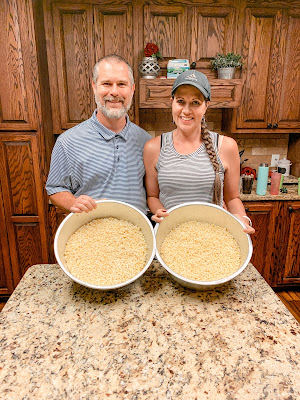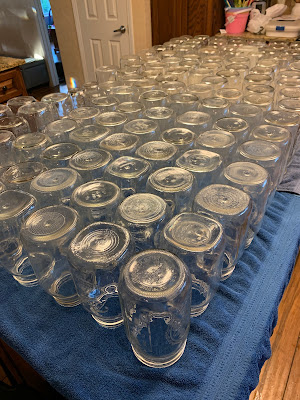Well y'all the first and second harvest of corn for the year 2020 has come in! Whoop whoop! It never fails that the corn and potatoes fall within seven days of each other. No matter how strategically we plan, they always need picking around the same time. Which means, a ton of round-the-clock work for all the members of our family. Thankfully, it's early in the summer garden season and we're still in good form, lol. Come talk to us the end of July and we'll be singing a different tune.
We have several more rows of corn coming up in stages so Lord willing we should get a decent harvest of corn. Prayerfully, we'll be able to meet our family quota and be able to sell some.
The crazy thing about corn is you pretty much have to pick, shuck, silk, and preserve it all in the same day. Which is why it takes every one in the family helping out.
Our first and second harvest of corn yielded over 400 ears. We shared some with neighbors, froze some ears for corn on the cob, and then skinned the rest for canned corn.
We were super thrilled to get a good harvest of corn, because we were completely out of both canned corn and corn on the cob. Our yearly goal for frozen corn on the cob is 30 bags of ten ears and our goal for canned corn is 50 pints. These goals pretty much allow us to eat corn on the cob nearly once a week for the year and we can add canned corn to meals once a week. I'd love to put 50 bags of corn on the cob in the freezer, but that just isn't so easy when you only have two freezers. Due to limited freezer space we really have to be intentional with what we store in them. No worries though, because any extra is easily sold around these parts.
When it comes to shucking and silking the corn, everyone gathers around under the shade tree and gets to work. We even bring out the super-sized industrial fan to help cool us off. Shucking and silking corn is a great job for children. There's nothing better than finding a worm and getting to play with it, lol. Well, maybe that's just a southern country kid past time. Nevertheless, with our large crew we typically make quick work of shucking and silking hundreds of ears of corn.
All the husks and silks are brought to the compost pile to be worked back into the soil at a later date. I can't say it enough, everyone who has a garden should have a compost pile that they are continuously adding to so that you are able to add those vital nutrients back into your garden soil.
With our first two harvests of corn we managed to freeze 21 bags of corn on the cob, nearly reaching our goal with several more harvests to go. If you'd like to see how we preserve corn on the cob, check out this post.
After the children were put to bed my husband and I had a late night date skinning corn to be canned. We had a friendly competition to see who could skin the most ears ~ I won't tell ya who won, lol.
The corn looks so pretty. It may take a lot of work to get the corn harvested and ready to preserve, but it is so worth it. There is nothing like farm fresh corn. So much so that most of us had rather not eat corn if it isn't farm fresh. I guess we're just a tad bit spoiled, peaches and cream corn really is the cream of the crop and we are so blessed to be able to grow it.
I'm so grateful for such a bountiful harvest, while we may do a ton of work planting, weeding, harvesting, and preserving we know that it is God who is the giver. It is only through the Lord that we can do anything especially in regards to gardening and growing our own food. There have been so many times over the years that we have heavily relied on our garden to feed our family. And now with my husband losing his job it seems all the more important that we grow as much as possible. I have no doubt that God is going to provide for our family one way or the other. But, it definitely fills me with much hope when we're picking like we have been this year. God truly is amazing and will always meet our every need.
With Love & Hope,
Jennifer


































